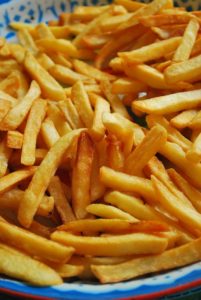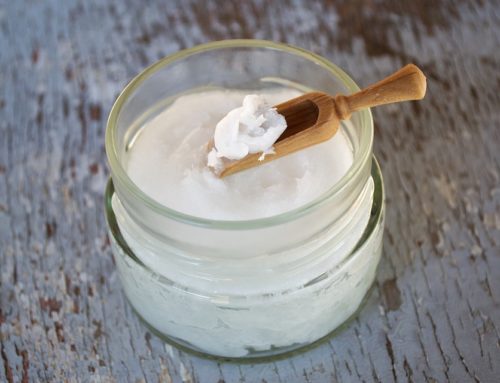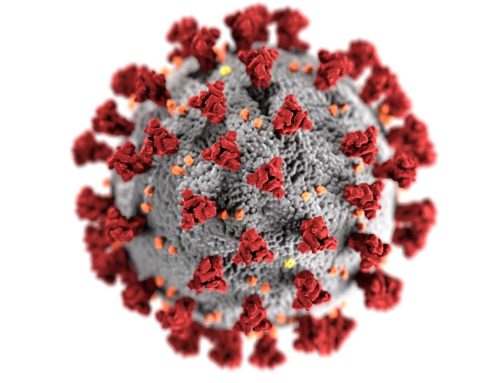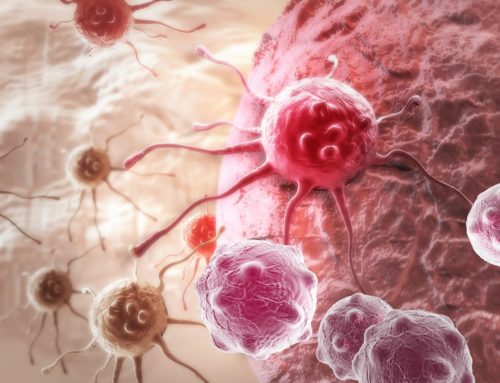Healthy fries and healthy deep frying?
Only extra virgin coconut oil, nothing else, please

All the big brands sell oil for deep frying, but unfortunately they are extremely unhealthy. Refined vegetable oil, deodorized oil, hardened vegetable oil or hardened animal fats. Most people use these oils to bake and deep fry and cookie manufactur- ers also use these cheap refined oils. Such oils deregulate bodily functions, are bad for our cell membranes and will break down our vitality as soon as you put one fry in this fat. After 7 or 11 times these fats have become explosively dangerous and even manufacturers agree that you shouldn’t be using them again.
Luckily there is a way of eating healthy fries, probably the best that you have ever tasted. Fries deep-fried in extra virgin coconut oil are super healthy and delicate and tasty. Extra virgin coconut oil is a super healthy oil, which maintains its healthy prop- erties and which doesn’t become harmful when heated! Theoretically this oil can last for ever if it is filtered. I do however recommend changing it after two years. Don’t forget to cover your frying machine after use.
Attention: So don’t use deodorized, hardened, partially hardened or refi ned coconut fat, only extra virgin!!! The coconut aroma is largely lost and the fries will have an extremely mild taste, which you can only get with coconut oil.
The most suitable frying; stir frying and deep frying oil?
| % saturated | % mono | % polyunsaturated | ||||||||
| The best! The only stable oils to deep-fry with, only replace after 2 years, Filter regularly, excellent for deep-frying, frying and stir-frying. |
||||||||||
| Extra virgin coconut oil | 92 | 6 | 2 | |||||||
| Extra virgin palm kernel oil | 85 | 13 | 2 | |||||||
| & nbsp; |
||||||||||
|
Excellent alternatives: For 7 to 10 times deep-frying, |
||||||||||
| Extra virgin cocoa butter | 59 | 39 | 2 | |||||||
| Non-hardened bovine fat | 59 | 38 | 3 | |||||||
| Non-hardened sheep fat | 52 | 45 | 3 | |||||||
| Clarified butter (ghee) | 63 | 31 | 6 | |||||||
| Babassu, Capu Assu and Shea butter | ||||||||||
|
Good alternatives: Less suitable for repeated deep-frying, |
||||||||||
| Extra virgin red palm oil | 50 | 40 | 10 | |||||||
| Non-hardened pig fat | 55 | 34 | 11 | |||||||
| Non-hardened goose fat | 33 | 56 | 11 | |||||||
| Extra virgin cashew oil | 20 | 73 | 7 | |||||||
| Extra virgin olive oil | 16 | 76 | 8 | |||||||
| Extra virgin macadamia oil | 12 | 71 | 7 | |||||||
| Extra virgin avocado oil | 20 | 70 | 10 | |||||||
| Extra virgin sesame oil ** | 13 | 42 | 45 | |||||||
| Special* sunflower oil | 10 | 81 | 9 | |||||||
| Special* safflower oil | 8 | 80 | 12 | |||||||
| * Hybrid types with low levels of polyunsaturated fatty acids and many monounsatu rated fatty acids, need to be extra virgin grade. ** contains sesamine, which controls the monounsaturated fatty acids reasonably well. | ||||||||||
* Hybrid types with low levels of polyunsaturated fatty acids and many monounsatu rated fatty acids, need to be extra virgin grade. ** contains sesamine, which controls the monounsaturated fatty acids reasonably well.
General rules for frying oils
Healthy saturated fat: Eminently suited for heating, several times even. The properties are maintained when heating. Monounsaturated: Suited for heating, preferably not repeated. Polyunsaturated: Not suited for heating, certainly not repeated. These oils oxidize and become harmful due to warmth, light and oxygen.
The smoke point of the oil is also important. As soon as the oil starts to smoke, the oil is extremely harmful. Smoking oil is unhealthy. The sharp odour of smoking burnt oils is known as acroleine. Acroleine causes irritation of the airways, and also increased pressure on them; the breathing rhythm is also lowered. But as I recommend everyone never to heat beyond 180°C, this is of lesser importance. Higher temperatures are not only unhealthy for the fat; they are also unhealthy for the food itself. Higher temperatures will for example cause heterocyclic amines (harmful proteins) in the food.
Stir-frying at very high temperatures for example is highly harmful for the fat and the food. The smoke point differs depending on the quality and the type of oil. The lower the degree of acidity, the higher the smoke point. The better the quality of the oil, the higher its smoke point will be. For example extra virgin olive oil might have a smoke point anywhere between 139°C to 207°C. Of course oils are only suitable if they are extra virgin (see the disadvantages of refined oils): Not hardened, non-refined, non-deodorized, not bleached, and not tampered with. Moreover only organic, because fats store pesticides, herbicides, antibiotics, PCBs, etc.
|
BAKING FATS/OILS THAT ARE OFTEN USED, BUT THAT ARE BAD INCLUDE: |
||||||||
| Saturated | mono | polyunsaturated | ||||||
|
Bad for heating |
||||||||
| Peanut oil | 19 | 51 | 30 | |||||
| Rapeseed oil (canola) | 9 | 61 | 30 | |||||
|
Even worse |
||||||||
| Corn oil | 17 | 24 | 59 | |||||
| Soya oil | 14 | 28 | 58 | |||||
|
The worst for heating |
||||||||
| Sunflower oil (ordinary) | 11 | 21 | 67 | |||||
| Safflower oil (ordinary) | 12 | 13 | 75 | |||||
| These oils contain too many polyunsaturated fats and become harmful as soon as you heat them.
When unrefined, these oils are perfect for using cold; but only cold! |
||||||||
Almost all frying oils, which are sold specifically for frying, are detrimental to our health, even when used cold (they have been refined!). They often contain transfats and become even more detrimental when heated (oxidation). Regardless of what the packaging says! Most manufacturers don’t even know themselves.
Frying, stir-frying and deep-frying gives rise to monstrous free radicals in polyunsaturated fats
Free radicals are aggressive substances, which make us age and contribute to most western diseases. The reason why free radicals are so dangerous is the fact that they contain an unpaired electrode. From a chemical point of view, this is highly unfavour- able situation: They will try to steal an electrode from another molecule and to pair it, which is a much more stable situation. Unfortunately the next molecule will then become an unstable free radical. In this way free radicals bring about a chain reaction in our body and are detrimental for valuable protein, DNA and RNA. Wrinkles are formed and illnesses such as cancer, Alzheimer’s, Parkinson’s, arthritis, cardiovascular disease, etc. are promoted. Sometimes these free radicals, which become superactive and super aggressive when heated, will mean that the heating of food is an important cause of the formation and absorption of free radicals. How to prevent this? Free radicals will rapidly affect (refined) polyunsaturated fatty acids, but will barely or not have any effect on the stable saturated fats. That is why you should always use stable fats for heating. Preferably saturated fats (coconut and palm kernel oil) or in second instance use mono-unsaturated fats or oils (for example olive oil). Never use monounsaturated fats (for example soya, peanut or sunfl ower oil). Light, oxygen and especially heat are extremely bad for monounsaturated fatty acids, and especially when they are heated at high temperatures, when frying, deep-frying or stir-frying. When heating monounsaturated fatty acids a lot of thermolythic and oxidative reactions come about. Decomposition products such as oxidized sterols, oxidized fatty acids, peroxides, harmful hydrogens, and aromatic bonds (such as PAHs for example) are produced. This will result in a whole chain reaction of free radicals. Ozone-induced reactive free radicals can react with sulfhydryl groups of proteins, as well as with unsaturated fatty acids, and are extremely destructive at cellular wall level.
Heating changes food
Heating generates chemical changes both in the oil that we are using to fry, as well as in the
food. S. Schaeffer mentioned in her book ‘Instinctive Nutrition’
that 400 known and unknown substances are generated when cooking a potato. The changes are quite noticeable for example when we heat a corn kernel and popcorn is made. The vita- mins and other vegetable substances are partially lost. Food is additionally weakened in order to combat free radicals. That is why you should avoid eating reheated food, from a nutritional point of view. Such food will give you the necessary calories, but no vitality. On the contrary. The nutrients have been partly lost and the food is probably teeming with free radicals and bacteria.
High temperature forms acrylamides. How to absorb fewer acrylamides?
Starchy foods and especially sugar will react with proteins at high temperatures. This so-called Maillard reaction will cause alloys between the sugar molecules and the proteins known as acrylamides. Acrylamides promote the ageing process, can be car- cinogenic in high doses, affect the nerves and will make men infertile. How to generate fewer acrylamides?
- Tests in Sweden, England and the US have shown that the Maillard reaction is morefrequent at high temperatures such as when grilling, roasting, baking, toasting, barbecuing and deep-frying. The higher the temperature, the more acrylamides will be present.
- Where can we fi nd these harmful substances? A Belgian study allocated rough values: Chips and tortilla chips (500 and more), gingerbread, popcorn, cornfl akes, breakfast and more), gingerbread, popcorn, cornflakes, breakfast cereals, muesli, cookies and coffee (between 200 and 400), fries and pure chocolate (150, which is relatively low).
- Home-made fries will give less rise to acrylamides than purchased fries, because sugar has often been added to the latter, which will promote the production of acrylamides. Tests have shown that the acrylamide levels in fries are not always identical. In the Netherlands the follow- ing has been recommended: Do not fry them until they are brown, but golden yellow, use temperatures lower than 180°C, do not prebake them in the microwave oven, and certainly never use potatoes that have sprouted.
- In the industry acrylamides will be generated when producing plastics (so use less plastic). They are used during the processing of water (so always drink water from glass bottles) and finally are also present in pesticides, sometimes between 25 to 30%. They prevent pesticides from being volatile and promote their adhesion to the vegetables, grain or fruit on which they are being used (yuck, Monsanto). I am convinced that organic fries and the organic versions of the aforementioned products will contain less acrylamides for this reason alone.
- Ammonium bicarbonate will also increase the level of acrylamides produced during the heating process.
The moral of this story: Make your own organic fries, fry them in organic extra virgin coconut oil and never heat over 180°C.










